by Andrey Shental // Mar. 7, 2024
In the era of techno-feudalism, one’s fortune is dictated by mastery of the algorithm. Patents, copyrights and know-how serve as the protective walls of modern citadels, shielding the wealth and well-being of digital lords from us, the ignorant user-serfs. Big Tech gurus, preaching through online and offline platforms, portray the code as all-powerful, often exaggerating its potency to further empower themselves. And unlike traditional capitalism, which hypocritically promised mobility, the ineffable and unidentifiable clouds eliminate any possibility of change. With around 40 artists (excluding two who are boycotting as part of the Strike Germany campaign), ‘Poetics of Encryption’ at KW, along with the eloquent book authored by its curator Nadim Samman, offers an encyclopaedic travel guide to navigate the Hades of the Algo-empire.
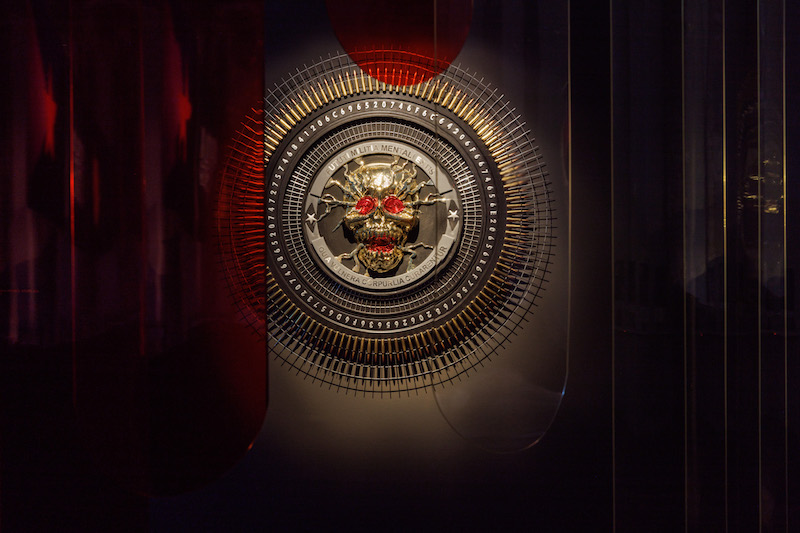
Trevor Paglen: ‘Because Physical Wounds Heal…,’ 2022, mixed media, installation view of the exhibition ‘Poetics of Encryption’ at KW Institute for Contemporary Art, Berlin 2024 // Photo by Frank Sperling, courtesy of the artist and Pace Gallery
At first glance, the show replicates the rhetorical tropes of inaccessibility. The ground floor of KW is transformed into neo-feudalist dim catacombs: black walls, dark cinematic boxes, no light source. Low-attached labels that are only legible with the aid of a smartphone flashlight make the meaning of the pieces as protective and elusive. This impenetrability is epitomized by Carsten Nikolai’s ‘anti’ (2004), a completely obscure three-dimensional structure installed in the middle of a room. Whereas classical minimalist sculpture enhanced human capacity to use a priori knowledge to mentally complete basic forms while seeing their parts, this object does not provide a clue to its back or its inside. It acts as a cryptic monolith from ‘2001: A Space Odyssey’ or a Big Dumb Object, which are popular figures of speculative and uncritical philosophy. Contrary to the tradition of art, meant to decipher reality distorted by class relations, the exhibition intro seems to obfuscate knowledge and paralyze action.
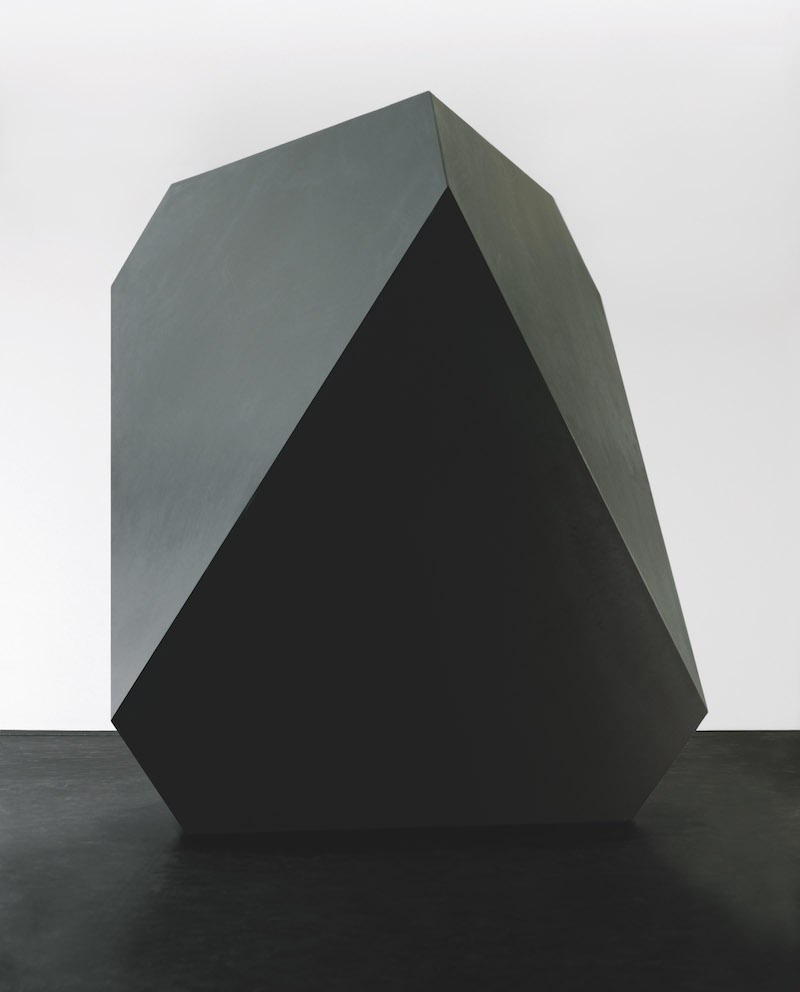
Carsten Nicolai: ‘Anti,’ 2004 // Photo by Uwe Walter, courtesy of Galerie EIGEN + ART Leipzig/Berlin
Yet, unlike what cloudalists claim, the digital world is defined by dialectics: the impenetrability of increasingly complex technology coexists with increasing transparency, made possible by the internet itself. Consider YouTube tutorials, which teach everything from basic DIY techniques to using VPNs or evading face recognition. Vladan Joler’s ‘New Extractivism’ (2022), presented in the slightly dimmed main hall of KW, is akin to Robert Bresson’s ‘A Man Escaped’ redefined for the 21st century. Instead of meticulously demonstrating how to escape from prison, it elucidates in black and white diagrams how to evade the “Platopticon,” a blend of the delusional Platonic cave and Foucauldian panopticon. One could observe Joler’s further monumental study, created in collaboration with AI researcher Kate Crawford. Their Marshall McLuhan-esque gigantic diptych ‘Calculating Empires,’ (2023) spanning the vast sidewalls, illustrates the longue durée of technological evolution over the past half-millennium. Against the feudal fragmentation of knowledge into protective subdisciplines, characteristic of the present moment, it offers a grand theory of everything that enables us to perceive the world in its totality. Tracing diverse phenomena such as pigeon post, colonial genocide or alchemy, it delineates how we arrived at a dystopian society of imperial domination and civic control, where Germany’s current McCarthyism emerges as a leading force.
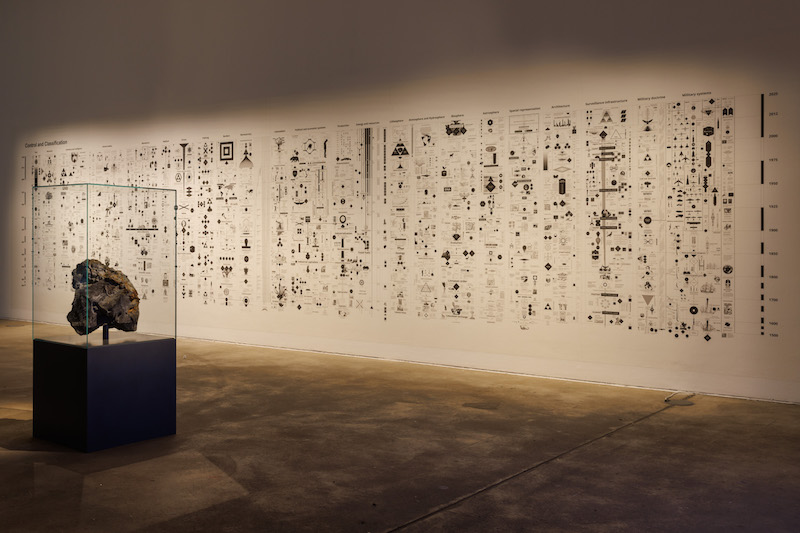
Julian Charrière: ‘Metamorphism XIII,’ 2016, artificial lava, molten computer waste (main boards, CPUs, RAMs, hard drives, cables, etc.), corian pedestal, steel, white glass. private collection, Berlin // Courtesy DITTRICH & SCHLECHTRIEM, Berlin [front] / Kate Crawford & Vladan Joler: ‘Calculating Empires,’ 2023, two prints on nonwoven wallpaper, two accompanying books // Courtesy the artists [detail, back], installation view of the exhibition ‘Poetics of Encryption’ at KW Institute for Contemporary Art, Berlin 2024 // Photo by Frank Sperling
In digital feudalism, the accessibility of truth is proclaimed to be impossible. Misinformation, fake news and deep fakes lead the masses to distrust any authority and embrace conspiracy theories. Some of the other works focus on how digital technology distorts reality, ranging from public-pleasing pieces like Eva and Franco Mattes’ viral memes turned into taxidermies (‘Half Cat and Panorama Cat,’ 2020 and 2022) to the mysterious Emmanuel Van der Auwera’s ‘VideoSculpture XXV (Archons)’ (2022). In the latter, the screen remains blank, while only its reflection on the floor is visible, suggesting a future where avatars substitute humans and viruses affect our perception. Against this backdrop, Nora Al-Badri’s ‘Post-Truth Museum’ stands as anti-defeatist and anti-relativizing. In this video, the artist produced deep fakes of three top museum directors or specialists in cultural heritage: Jean-Luc Martinez (Louvre), Hermann Parzinger (president of Stiftung Preußischer Kulturbesitz) and Hartwig Fischer (ex-director of British Museum). In their insurgent interviews, all three white men speculate on decolonial collections of the future, delegitimizing the very modus operandi of their enterprises as knowledge gatekeepers. The manipulation of facial appearances, a tool typically used by techno manipulators themselves, is thus repurposed. It not only brings the moment of restitution closer, but talks through the very truth of the museological unconscious: without returning stolen goods that may constitute the overwhelming majority of collections, the colonial and racist relationships will persist to define the European exhibitionary complex.
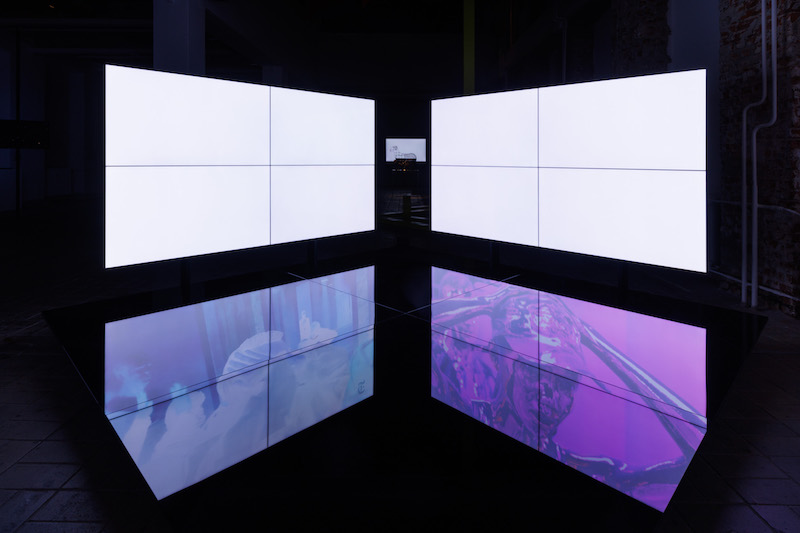
Emmanuel Van der Auwera: ‘VideoSculpture XXV (Archons),’ 2022, 8 LCD screens, black glass, cables, 19’ HD video, color, sound, installation view of the exhibition ‘Poetics of Encryption’ at KW Institute for Contemporary Art, Berlin 2024 // Photo by Frank Sperling, courtesy of the artist and Harlan Levey Projects
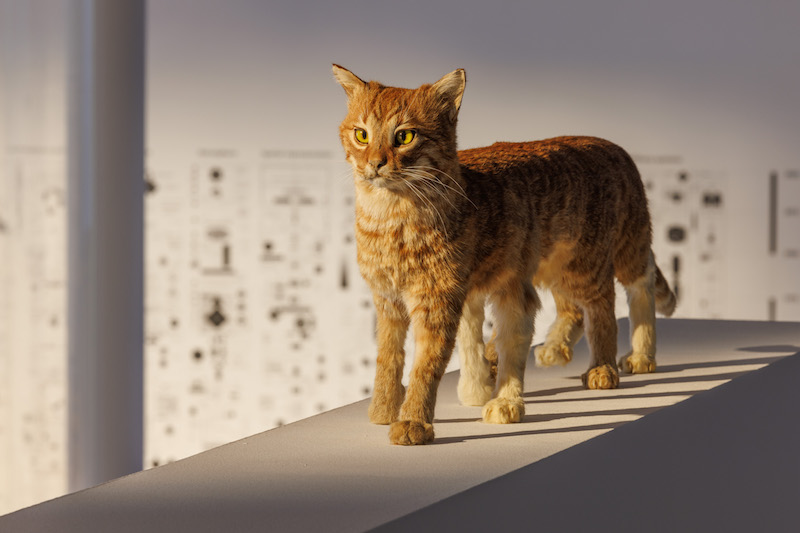
Eva & Franco Mattes: ‘Panorama Cat,’ 2022, taxidermy cat, installation view of the exhibition ‘Poetics of Encryption’ at KW Institute for Contemporary Art, Berlin 2024 // Photo by Frank Sperling, courtesy of the artists and APALAZZOGALLERY
In addition to self-aggrandizing and relativizing, the new digital economy performs another, even more disturbing tendency. Critique today is not only co-opted but also reduced to feedback or rating to make the systems runs smoother. Seen in this light, certain pieces felt like a broken record of the 9th Berlin Biennale, ‘Present in Drag’ (2016) (KW was one of its locations). Sterling Crispin’s video, positioned high on the ceiling is titled ‘Ginsberg’s Moloch – AI Nightmare Edition’ (2023) and merely transforms beatnik poems into product advertisements with use of talking heads and stock imagery. Andrea Khôra’s ‘Rapture’ (2024) is a more inventive and witty commentary on the revival of New-Age ideology inside Silicon Valley. Made in the form of a recorded podcast with a CEO of psychedelic startup TranscendX, it occasionally slips into AI-generated ketamine-aesthetics. These works, in a sense, get into the same trap as the aforementioned biennale and could be summarised by what Hal Foster called “the art of cynical reason”: simultaneously ideological and enlightened, they are ambivalent and immune from criticism. But while criticising neo-feudalism by mimicking and “coquetting” with it, they inadvertently become homologous with the subject of their own critique.
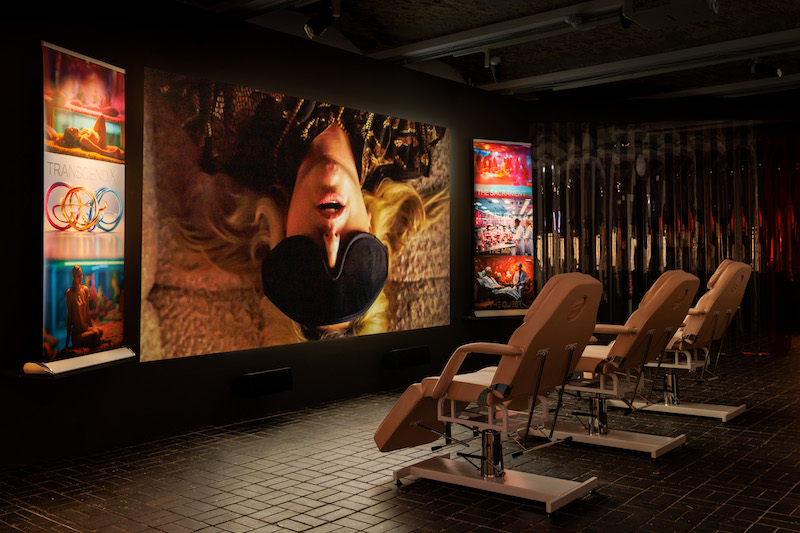
Andrea Khôra: ‘Rapture,’ 2024, video, sound, 24’10”, medical chairs, roller banners, installation view of the exhibition ‘Poetics of Encryption’ at KW Institute for Contemporary Art, Berlin 2024 // Photo by Frank Sperling, courtesy the artist
Yet, one might view Matthias Planitzer’s 3D-video ‘A Boring Dystopia’ (2023) as an antidote to this cynicism. No less spectacularly installed to simulate the interior of an Airbus plane, it depicts a grim post-Singularity zombie world that we are gradually approaching. Humanity there is entirely submerged in technocracy, the names of resistance fighters are erased, their struggle is reduced to mere instructional material for the system and the only way to express dissent is poetic riddles. However, the protagonist offers a ray of hope by reciting a maxim from one of his resilient friends that the dog doesn’t fear the leash, but the master does. Following the laws of Hegelian dialectics, the free self-consciousness of techno-lords is solely predicated on recognition by the user-serfs, who are forced, for instance, to sign the “Terms and Conditions.” But this recognition comes from someone whom the cloudalists themselves do not regard as equals, and therefore their own freedom is not worth a penny. The forthcoming liberation belongs to the slave and not to the present master.
Exhibition Info
KW Institute for Contemporary Art
Group Show: ‘Poetics of Encryption’
Exhibition: Feb. 17–May 26, 2024
kw-berlin.de
Auguststraße 69, 10117 Berlin, click here for map



















